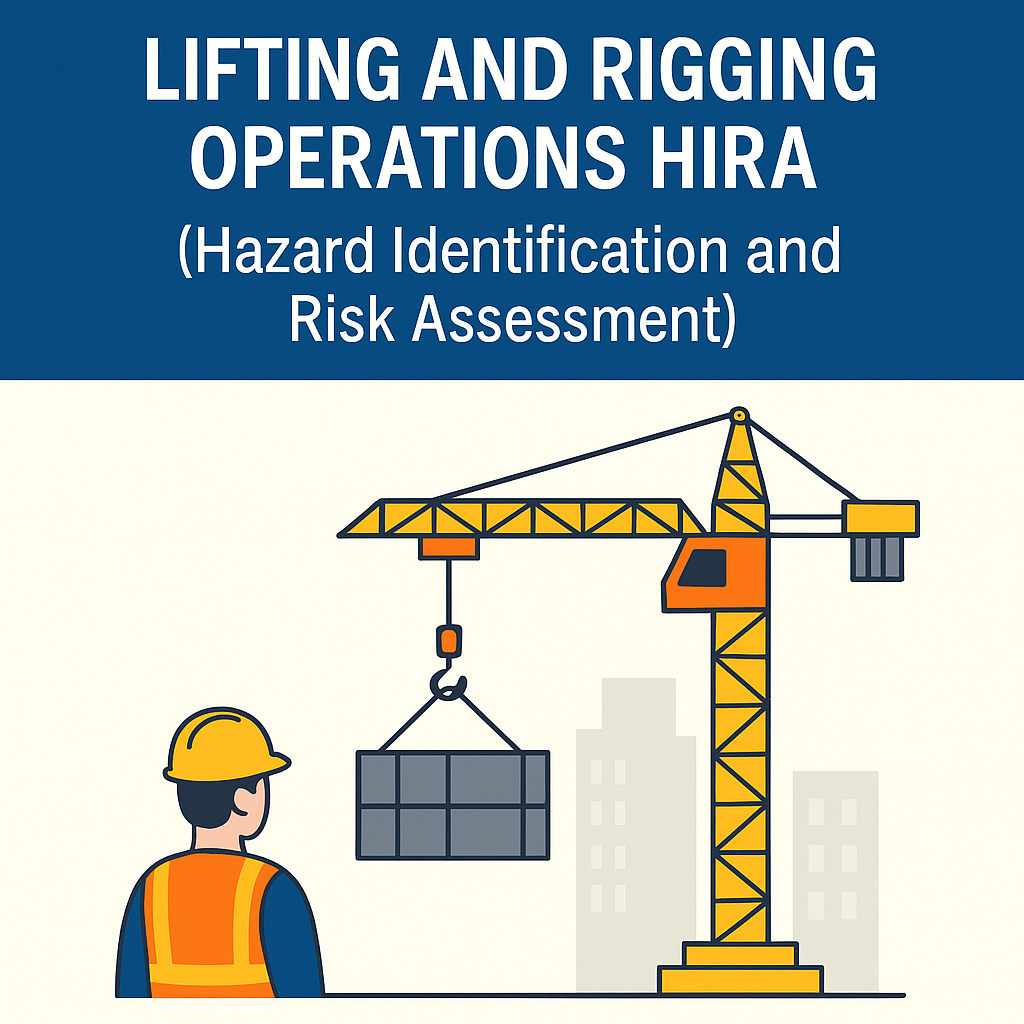
Lifting and Rigging Operations HIRA – Top 10 Critical Hazards and the Ultimate Safety Guide
📘 Introduction
Lifting and rigging activities are an essential part of construction, oil and gas, infrastructure, and industrial operations. Whether it’s hoisting a structural steel beam, installing a generator, or lifting prefabricated units, these operations pose serious risks.
Improper rigging, equipment failure, or lack of hazard awareness can result in dropped loads, structural collapse, electrocution, or fatal injuries. This is why a detailed Lifting and Rigging Operations HIRA (Hazard Identification and Risk Assessment) is not just recommended—it’s critical.
According to OSHA’s lifting safety regulations, lifting-related incidents account for over 20% of construction-related fatalities annually. These accidents are largely preventable through proper hazard assessment and control implementation.
🎯 Objective of the HIRA
The purpose of this Lifting and Rigging Operations HIRA is to:
- Identify critical hazards associated with lifting operations.
- Assess the risks based on probability and severity.
- Recommend engineering, administrative, and PPE controls.
- Ensure legal and procedural compliance with:
📌 Scope of Lifting and Rigging Operations HIRA
This risk assessment applies to:
- Manual and mechanical lifting using tower cranes, mobile cranes, overhead cranes, forklifts, and hoists.
- Rigging setups using slings (wire rope, synthetic), shackles, eyebolts, hooks, and spreader beams.
- Single-point, tandem, and critical lifts.
- Ground crew, crane operators, signalmen, supervisors, and safety professionals.
🧱 Step-by-Step Hazard Identification and Risk Assessment (HIRA)
1. Activity Description
The activity involves the lifting, positioning, and installation of heavy materials or components using cranes or lifting devices supported by rigging accessories. The process includes load assessment, securing lifting gear, conducting the lift, and placing the load in its final position.
⚠️ Top 10 Hazards in Lifting and Rigging Operations
| Hazard | Potential Consequences | Who’s at Risk? |
|---|---|---|
| 1. Load drop due to sling failure | Fatal injury, asset damage | Riggers, workers |
| 2. Crane tipping or overloading | Collapse, serious injuries | Operator, public |
| 3. Improper rigging or angle | Load swing, dropped item | Signalmen, engineers |
| 4. Struck-by swinging load | Head trauma, fractures | Ground crew |
| 5. Use of defective rigging gear | Sudden collapse | Everyone on site |
| 6. Load imbalance / COG error | Instability, fall | Riggers, load handlers |
| 7. Electrical hazards (overhead lines) | Electrocution, fire | Crane operator |
| 8. Environmental hazards (wind/rain) | Loss of control | Crew, operator |
| 9. Miscommunication between operator and rigger | Uncoordinated lift | All personnel |
| 10. Obstructed lifting path | Collision with structures | Crane boom, structures |
🔎 Risk Assessment Matrix
| Hazard | Likelihood (L) | Severity (S) | Risk Rating (L×S) | Risk Level |
|---|---|---|---|---|
| Load drop | 3 | 5 | 15 | High |
| Crane tipping | 2 | 5 | 10 | High |
| Poor rigging | 3 | 4 | 12 | High |
| Swinging load | 4 | 4 | 16 | Critical |
| Electrical contact | 2 | 5 | 10 | High |
Scale: 1 = Low, 5 = High
🛠️ Control Measures
✅ Engineering Controls
- Use load-rated lifting accessories with valid inspection.
- Install crane safety systems: load indicators, anti-two block devices, boom limiters.
- Barricade lifting zones and enforce exclusion areas.
- Use tag lines to control load sway.
- Secure lifting paths and eliminate obstructions.
✅ Administrative Controls
- Conduct pre-lift meetings, including toolbox talks and JSA.
- Develop an approved Lifting Plan and Permit-to-Work.
- Assign trained and certified crane operators, riggers, and signalers.
- Establish and standardize communication signals.
- Monitor wind speed and suspend lifts above 20 mph.
✅ Personal Protective Equipment (PPE)
- Safety helmet with chin strap
- Steel-toe safety boots
- Cut-resistant gloves
- Reflective vests (Hi-Viz)
- Safety goggles or face shields
- Hearing protection in high-noise zones
🧰 Safe Work Procedure (SWP)
✅ Before the Lift
- Verify equipment and accessories are certified and inspected.
- Check load weight and center of gravity.
- Assign clearly defined roles.
- Conduct site inspection and ensure access routes are clear.
- Review emergency stop plans.
✅ During the Lift
- Use taglines for stability.
- Keep communication clear and unambiguous.
- Stop work if visual contact is lost between operator and signalman.
- Never pass a load above personnel or occupied areas.
✅ After the Lift
- Lower load slowly and ensure it’s stable before releasing rigging.
- Inspect lifting gear for wear and damage.
- Record operation in the lifting register.
🆘 Emergency Preparedness
- Emergency stop button on crane
- Nearby first aid kits and trained responders
- Access to fire extinguishers for electrical risks
- Clearly marked evacuation routes
- Rescue plan for trapped or injured workers
👤 Roles and Responsibilities
| Position | Responsibility |
|---|---|
| Site Engineer | Approve lifting plan and verify site readiness |
| Supervisor | Assign qualified personnel and monitor execution |
| Safety Officer | Audit gear, verify documents, enforce compliance |
| Rigger | Select and attach proper gear, inspect slings |
| Signalman | Direct the operator with signals or radio |
| Crane Operator | Execute lift safely and follow instructions |
📊 Monitoring and Review
- Daily inspection logs for slings, hooks, and shackles.
- Monthly crane and rigging equipment audits.
- Near-miss reporting and investigation log.
- Refresher training every 6–12 months for rigging crew.
- Review and revise HIRA after every incident or major change in lifting activity.
✅ Conclusion
A well-structured Lifting and Rigging Operations HIRA is your best line of defense against fatal incidents, equipment damage, and regulatory violations. By identifying hazards, evaluating risks, and implementing control measures aligned with OSHA and ASME standards, you foster a safer and more efficient working environment.
Don’t cut corners—plan your lift, inspect your gear, and protect your crew. Implement this HIRA as part of your lifting safety strategy and ensure every lift is a success.
Equipment Installation and Commissioning HIRA (Hazard Identification and Risk Assessment)
Shuttering and De-shuttering Work HIRA (Hazard Identification and Risk Assessment)
Road Cutting and Paving HIRA (Hazard Identification and Risk Assessment)
Site Housekeeping Activities HIRA (Hazard Identification and Risk Assessment)
Tower Crane Operation HIRA (Hazard Identification and Risk Assessment)

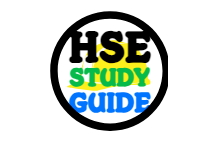
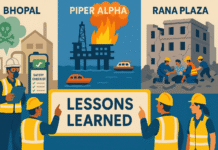
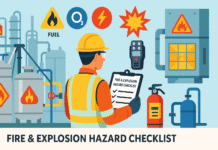
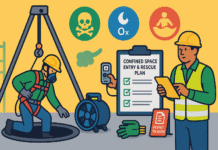




















Good 👍